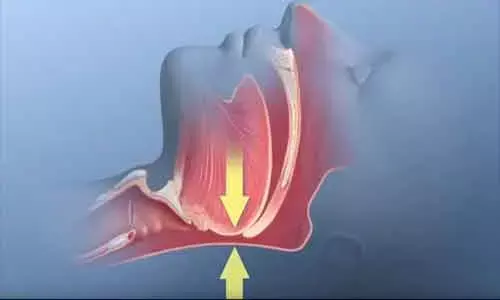- Home
- Medical news & Guidelines
- Anesthesiology
- Cardiology and CTVS
- Critical Care
- Dentistry
- Dermatology
- Diabetes and Endocrinology
- ENT
- Gastroenterology
- Medicine
- Nephrology
- Neurology
- Obstretics-Gynaecology
- Oncology
- Ophthalmology
- Orthopaedics
- Pediatrics-Neonatology
- Psychiatry
- Pulmonology
- Radiology
- Surgery
- Urology
- Laboratory Medicine
- Diet
- Nursing
- Paramedical
- Physiotherapy
- Health news
- Fact Check
- Bone Health Fact Check
- Brain Health Fact Check
- Cancer Related Fact Check
- Child Care Fact Check
- Dental and oral health fact check
- Diabetes and metabolic health fact check
- Diet and Nutrition Fact Check
- Eye and ENT Care Fact Check
- Fitness fact check
- Gut health fact check
- Heart health fact check
- Kidney health fact check
- Medical education fact check
- Men's health fact check
- Respiratory fact check
- Skin and hair care fact check
- Vaccine and Immunization fact check
- Women's health fact check
- AYUSH
- State News
- Andaman and Nicobar Islands
- Andhra Pradesh
- Arunachal Pradesh
- Assam
- Bihar
- Chandigarh
- Chattisgarh
- Dadra and Nagar Haveli
- Daman and Diu
- Delhi
- Goa
- Gujarat
- Haryana
- Himachal Pradesh
- Jammu & Kashmir
- Jharkhand
- Karnataka
- Kerala
- Ladakh
- Lakshadweep
- Madhya Pradesh
- Maharashtra
- Manipur
- Meghalaya
- Mizoram
- Nagaland
- Odisha
- Puducherry
- Punjab
- Rajasthan
- Sikkim
- Tamil Nadu
- Telangana
- Tripura
- Uttar Pradesh
- Uttrakhand
- West Bengal
- Medical Education
- Industry
Obstructive sleep apnea and cardiovascular disease: AHA scientific statement

USA: The American Heart Association (AHA) has released a scientific statement on sleep-disordered breathing and cardiovascular complications.
The scientific statement, published in the journal Circulation, outlines screening, diagnosis, and treatment recommendations for obstructive sleep apnea (OSA) and cardiovascular (CV) complications associated with the sleep disorder.
Obstructive sleep apnea (OSA) is characterized by recurrent complete and partial upper airway obstructive events, resulting in autonomic fluctuation, intermittent hypoxemia, and sleep fragmentation. Its prevalence is as high as 40% to 80% in patients with hypertension, heart failure, coronary artery disease, pulmonary hypertension, atrial fibrillation, and stroke. Despite its high prevalence in patients with heart disease and the vulnerability of cardiac patients to OSA-related stressors and adverse cardiovascular outcomes, OSA is often underrecognized and undertreated in cardiovascular practice.
Key recommendations include:
· Screening for OSA is recommended in patients with resistant/poorly controlled hypertension, pulmonary hypertension, and recurrent atrial fibrillation after either cardioversion or ablation. In patients with New York Heart Association class II to IV heart failure and suspicion of sleep-disordered breathing or excessive daytime sleepiness, a formal sleep assessment is reasonable.
· In patients with tachy-brady syndrome or ventricular tachycardia or survivors of sudden cardiac death in whom sleep apnea is suspected after a comprehensive sleep assessment, evaluation for sleep apnea should be considered.
· After stroke, clinical equipoise exists with respect to screening and treatment.
· Patients with nocturnally occurring angina, myocardial infarction, arrhythmias, or appropriate shocks from implanted cardioverter-defibrillators may be especially likely to have comorbid sleep apnea. All patients with OSA should be considered for treatment, including behavioral modifications and weight loss as indicated.
· Continuous positive airway pressure should be offered to patients with severe OSA, whereas oral appliances can be considered for those with mild to moderate OSA or for continuous positive airway pressure–intolerant patients.
· Follow-up sleep testing should be performed to assess the effectiveness of treatment.
The AHA noted in the scientific statement that there is a significant need to further explore the use of wearable devices and remote monitoring tools for screening and treatment of OSA. In addition, better CV risk stratification protocols are needed for patients with OSA, the AHA concluded.
Reference:
"Obstructive Sleep Apnea and Cardiovascular Disease: A Scientific Statement From the American Heart Association," is published in the journal Circulation.
DOI: https://www.ahajournals.org/doi/10.1161/CIR.0000000000000988
Dr Kamal Kant Kohli-MBBS, DTCD- a chest specialist with more than 30 years of practice and a flair for writing clinical articles, Dr Kamal Kant Kohli joined Medical Dialogues as a Chief Editor of Medical News. Besides writing articles, as an editor, he proofreads and verifies all the medical content published on Medical Dialogues including those coming from journals, studies,medical conferences,guidelines etc. Email: drkohli@medicaldialogues.in. Contact no. 011-43720751


